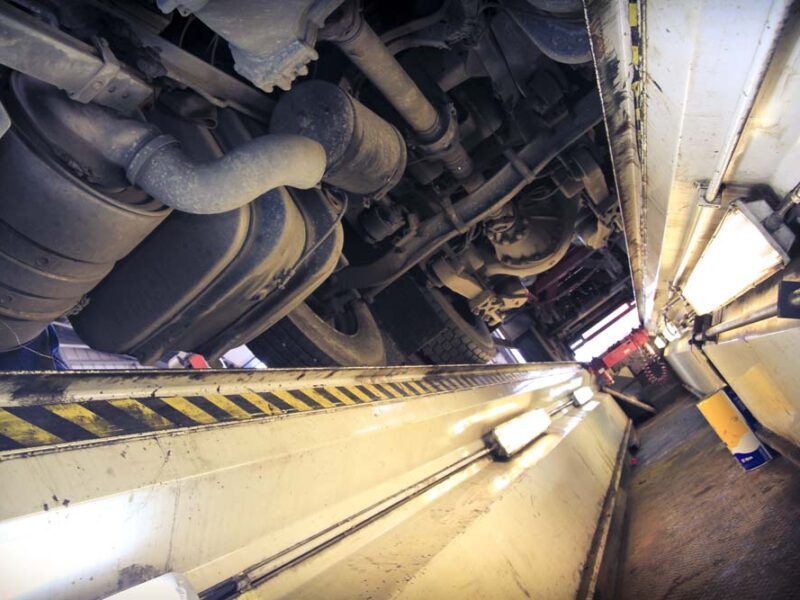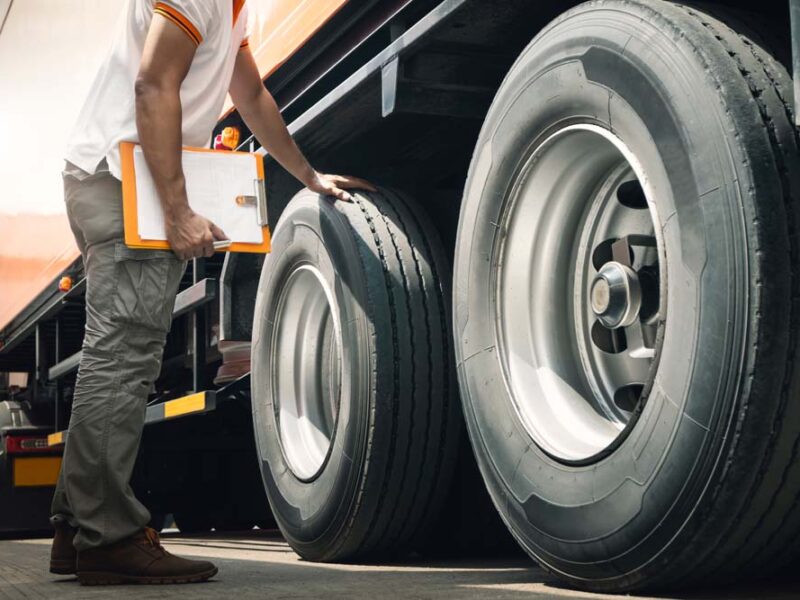Around 18 months ago, The Department for Transport issued a report on the state of Heavy Vehicle Testing in the UK, following disruption by the Covid-19 lockdown measures. The purpose of the review was to gain an understanding on whether current roadworthiness testing was fit for purpose and provide evidence on whether it supported or hindered the effective operation of the haulage and logistics industries. It also considered if heavy vehicle roadworthiness testing could be improved to better meet the needs of customers & suppliers, while delivering the inherent road safety and environmental benefits of vehicle testing. The review looked at the service provided during "normal" times, i.e. before March 2020 and compared that with the periods between March 2020 and August 2020, i.e. peak Covid!
Background to Statutory Testing Requirements
The Road Traffic Act 1988 prohibits the use of a heavy vehicle on a road unless a test certificate has been issued for that vehicle within the past year. Annual roadworthiness tests are carried out by Driver & Vehicle Standards Agency (DVSA) staff who are known as Vehicle Standards Assessors (VSAs). Under operator licensing rules, operators are required to ensure the conduct of regulation safety inspections at regular intervals (usually every 6 weeks or so) of their vehicles, to make sure that standards of vehicle maintenance are correctly maintained. The annual test, which is separate from the regular safety inspection is undertaken by an external, independent VSA.
The majority of heavy vehicle testing takes place at Authorised Testing Facilities (ATFs) located around the country. The DVSA has a contractual arrangement with each of the ATFs, which states the obligations for the ATF in terms of the provision of the testing facility and how to schedule vehicles for testing as well as specifying how the DVSA should schedule the VSAs which undertake the testing, in relation to that. In 2021 there were 436 full time VSAs able to conduct tests within the UK. the Government data for the year 2018-2019 as used in the report, shows that 432,778 HGV tests, 254,439 trailer tests and 77,766 PSV tests were carried out. That equates to 1,755 tests per year or 7.3 tests per day for each Vehicle Standards Assessor, allowing for holiday, sickness and weekends.
Conclusions & Updates
The Role of Testing in Ensuring Safety
Not surprisingly the 2021 report found that annual testing of heavy vehicles is an important element of the regulatory regime designed to support public safety. The testing is an independent check of an operator's fleet and thus its maintenance system's effectiveness in picking up faults and ensuring only road-worthy vehicles are used on the UK's roads. It concluded that although there is evidence to show that some vehicles are perhaps only "brought up to standard" in time for the annual test, the need for an annual test does have a positive effect on ensuring vehicle roadworthiness. The current update does not make mention of the point first muted in the original report, of relying on schemes such as the Earned Recognition (ER) scheme which is awarded to operators with a high compliance rate, to allow holders of these "badges" to benefit from less frequent testing intervals, i.e. to be able to extend the time between inspections to greater than 12 months. This would certainly free up testing space and VSA time, without one would hope road safety and vehicle roadworthiness being compromised.
Building More Certainty and Flexibility into the Testing System
During the 2021 review it was agreed that there is a "fair amount" of administration and having to shift some vehicles around in order to accommodate testing and re-testing of vehicles. Among the end users there was evident frustration about some of the obstacles and issues that operators faced negotiating the testing regime, with one operator reporting having to make 384 trips to ATFs other than their usual one in order to find open testing slots.
Building flexibility into the system was a key issue identified by stakeholders at the time, and the DVSA has acknowledged that the current process of booking testing capacity and tests can be both stressful and bureaucratic. To address this "bartering process" for testing capacity the DVSA is looking to move away from the current quarterly scheduling process with the ATFs to a system where they agree with each ATF a normal level of testing hours per day and that these stay in place, with reviews undertaken to ensure they are still adequate for the demand, rather than ATFs having to "bid" every quarter. If an ATF wanted to grow their businesses further or to accommodate a temporary peak, then they would be able to request a temporary (or permanent) change. This is only a proposal at present and the DVSA is welcoming feedback from operators and ATFs alike as to how useful it would be. It is hoped that such an approach would give both the certainty and flexibility to the ATFs that end users had asked for during the 2021 review and resultant implementation stage.
One other way that the DVSA has looked at to improve certainty and flexibility in the system is to build on the "Manage your Vehicle Testing" (MYVT) service for ATFs, which is currently being piloted at some sites. The aim is to extend the program to provide account information and enable ATFs to request when they want testing time or days and to be able to change what they have scheduled to meet local demand. The DVSA acknowledges that implementation of this system across the whole network will not "happen overnight" but they are keen to reform the booking process in 2023 and implement changes to achieve the aim of greater certainty and flexibility.
Thawing of Moratorium on New ATFs
The number of ATFs that are currently in operation had been limited by a moratorium on the establishment of new ATFs since 2017. This step was taken as an interim measure to stabilise and improve the service delivery by the DVSA at the time. When the report was published (2021) there were 575 ATFs in operation with around 50 potential new sites waiting for authorisation, should the moratorium be lifted. There was an argument put forward at the time, that allowing new sites to open might lead to increased flexibility in the system and greater competition between ATFs which might in turn lead to a reduction in 'pit fees'. However, this option needed to be viewed alongside the need to recruit more VSAs as both are needed if more appointment slots are to be realised.
In the present day, the DVSA reports that "some" new ATFs have been allowed to open and around 150 new VSAs have ben recruited, along with an increase in apprenticeship programme that the DVSA runs, to ensure the industry continues to attract new blood. The plan is for the number of operational VSAs in Great Britain to stand at 516 by the end of March 2023.
Improving Relationships
The 2021 review acknowledged that the heavy vehicle testing system has 3 participants - DVSA, the testing facilities (ATFs) and the end user - usually a road transport operator. The relationship between the DVSA and end user is "necessarily indirect" but both the testing facilities and the operators are customers of DVSA. Therefore, better information about the performance of the DVSA system and accompanying transparency was thought to be essential in improving these working relationships going forward. The report recommended that the DVSA should consider a "reset of the relationship" and the way its leadership liaises with representatives of service users in the road freight and passenger industries, citing as an example of where this relationship was unbalanced as the suspension of heavy vehicle testing across Great Britain in March 2020 due to Covid-19 restrictions, which saw all testing suspended whilst much of the logistics and some of the bus industries continued to operate with Covid secure procedures and the resulting difficulties with communications between the key stakeholders at the time.
Moving forward to 2022 the DVSA have used their industry forums to develop an initial set of service performance indicators which they hope will allow both sides to better understand the service and thus where or how improvements should be made. The measures include user satisfaction surveys, collecting data on cancellations and levels of appointments committed to. There is a link here to the DVSA Network Business Manager site where one can locate the correct person and ask for help with the information that the DVSA are sharing.
More Data you Say? No Problem!
Finally, the DVSA has implemented an enhanced MOT history service for operators. This service allows anyone to check on the MOT status of any vehicle. However, with heavier vehicles the data was not available in real-time and did not display a vehicle's full MOT history. Nor was it possible to get a digital copy of the vehicle's MOT certificate. In 2023 the DVSA is hoping to provide real-time MOT history and digital certificates for heavier vehicles. In the meantime, it is aiming to put in place a system where VSAs will be able to email a pdf copy of all the vehicle's MOT certificates at the point of test, which will undoubtedly be a useful addition to the whole process.
Ensuring that your heavy vehicles, whether they are HGVs or PSVs are properly maintained and receive their MOTs within the correct time frame is one of the key tenants of the road transport regulatory regime. These changes to the booking system will hopefully ease part of the administrative burden on transport operators. If you need any further advice on the rules and regulations around this aspect of transport operation then please do not hesitate to get in touch. You can click here to send an email or call 01279 818280 to speak to one of our lawyers. We are here to help.
(c) Richard Pelly December 2022

More News and Insight

Social Media – Have you Thought about your Employees’ Use?
Social Media is all encompassing in the modern world, but although it brings many positives, it can place employers in vulnerable positions if their employees’ use is not carefully defined…

Changes to the Clandestine Entrant Civil Penalty Scheme means a Stitch in Time Really Does Save Nine!
The Clandestine Entrant Civil Penalty Scheme has been in place for over 20 years. It is designed to complement law enforcement activity against criminals who smuggle people into the UK illegally as well as deter those who decide to try to enter the country without permission…

Driving in the UK? Read about the latest Rule Changes in 2024
Earlier this year various new driving laws were introduced, impacting both standard road users as well as HGV and PSV road users across England, Wales & Scotland. If you are driving in the UK, especially if you are a commercial driver, then you should ensure that you are aware of these amendments and new rules…

Self-Driving Cars on UK Roads to be Reality by 2026
It seems that one of the first areas that will be breaking the ground in the AI revolution into most people’s everyday lives will be Self-Driving cars! Of course we have heard all this before, and more than once!

Are You Taking your Responsibilities to Maintain your Vehicles Seriously?
Running a haulage business is not an easy undertaking. There are a multitude of decisions to be made on a daily basis before any driver actually gets behind the wheel and delivers the goods (or passengers!).

Update to the Guide to Registering & Operating Local Bus Services in England & Wales
The Senior Traffic Commissioner’s guide to registering and operating local bus services in England and Wales is intended to help operators of local bus services understand the requirements for registering a service.

Changes to the HGV & PSV Test Regime for Earned Recognition Operators
In March 2021 the Government began a review into the processes for commercial vehicle testing to look at ways it could improve the regime for operators whilst still maintaining high safety standards for any vehicle used commercially on the UK’s roads.

Employment Law Updates for 2024
The Government has confirmed several legislative employment law changes to be implemented 2024, which aim to bring about a “fairer workplace for employees”.

Campaign to Bar Schools from using Section 19 Permits
In March 2024 a campaign was started to end the operation of minibuses by schools and colleges under Section 19 permits.

Moving to a Digital First Approach in Heavy Vehicle Testing
The DVSA has published an update to their digital transformation project for heavy vehicle testing. The update is for the new Manage Your Vehicle Testing (MyVT) digital service across vehicle testing.

Traffic Commissioner Highlights Abuse of Section-19 Permits
In a Section 19 Public Inquiry hearing heard last year (2023) the Traffic Commissioner highlighted again the importance of permit operators ensuring that their vehicles allow passengers and other road users to be safe.

Enero Logistics Ltd – the Law for Operators on Agency Drivers
At one time or another, many transport companies need to rely on the services provided by agency drivers, to best cope with sudden fluctuations in demand or to fill driver shortages. This allows for the undisrupted continuation of services by these organisations.
